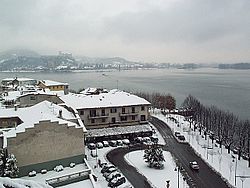Arona, Piedmont
Arona
Aruna (Lombard) | |
|---|---|
| Città di Arona | |
 Largo Garibaldi in winter. The castle in the background is in Angera. | |
UTC+2 (CEST) | |
| Postal code | 28041 |
| Dialing code | 0322 |
| Patron saint | Sts. Felinus and Gratian |
| Saint day | March 13 |
| Website | Official website |
Arona (Italian pronunciation:
History
Archaeological findings have shown that the area of what today is Arona was settled from the 18th–13th centuries BC. Prehistoric pile-dwellings have been found near the town and are part of the
.In the 11th century the Benedictine abbey of
After the siege and destruction of Milan in 1162 by Emperor Frederick Barbarossa, many of the exiled took refuge in Arona.
Later the town was a possession of the
It was in Arona that the twenty-year-old Oscar Wilde wrote his poem "Rome Unvisited" in 1875, travelling with his former Trinity College Dublin Classics Tutor, J.P. Mahaffy, lamenting that he had to leave Italy before having a chance to visit Rome.[3][4]
Geography
The city of Arona is located on the Piedmontese shore of Lake Maggiore and is crossed by the Vevera stream, which flows into the lake. Around there are the hilly bas-reliefs of morainic origin incorporated into the Lagoni di Mercurago Natural Park where, in 1860, the first pile-dwelling settlement found in Italy was identified. The hills are generally covered by woods that occupy more than half of the territory. 33% of the surface is occupied by urbanized areas, 9% by meadows or pastures; smaller percentages are allocated to parks, gardens and green sports areas (2.3%), vegetable gardens, orchards, nurseries and vineyards (1.7%), uncultivated herbaceous (1%) and arable land (0.4%).[5]
Main sights

Arona's main attractions include:
- Saint Charles Borromeo was commissioned by Cardinal Federico Borromeo, and construction began in 1614, completed in 1698. At 35.10 metres (115.2 ft) it was the largest bronze standing statue in the world, still second only to the Statue of Liberty. It is said that the architects behind the Statue of Liberty consulted the blueprints of the Sancarlone when laying out their own. The statue was intended as part of a complex of buildings and chapels celebrating the life of St. Charles, of which only three chapels were completed. Next to the statue are the 17th-century basilica and the former Archbishop's Palace. A smaller version of the statue, the Sancarlino, can be seen in Corso Cavour in the town.
- La Rocca ("The Castle") is a park owned by the Borromeo family. The park used to contain the castle of Arona, destroyed by the Napoleonic armies, and was the birthplace of St. Charles Borromeo himself. The park is freely open to the public and is a favourite of many locals; many animals are kept in semi-captivity in various areas of the park.
- The Lungolago ("Lakeside") offers a view of the castle on the opposite shore, the Rocca Borromeo di Angera, the lake and the Alps. Swimming in Lake Maggiore is now possible, after years of pollution. A beach has been refurbished by this group close to Piazza del Popolo in the town centre, called Le rocchette ("The little rocks").
- Collegiata della Natività di Maria Vergine (1482) - church has paintings of the life of the Virgin Mary by Pier Francesco Mazzucchelli, also known as Morazzone, and a Holy Family by Gaudenzio Ferrari.
- Santi Martiri
- Sacro Monte di Arona
The frazione of Mercurago is home to Lagoni Park, a protected area including a peat-bog, pastures dedicated to the breeding of thoroughbred horses and a woodland area. There are also some archaeological findings from the Bronze Age, including ancient wheels.
Transport

Arona is 25 kilometres (16 miles) north of Milan's
trains.Due to the town's size, there is no public transport, but some bus companies connect the town to its frazioni of Dagnente, Campagna, Mercurago and Montrigiasco, and to neighbouring municipalities.
Arona is near a confluence of motorways, and from there one can head for Milan, Genoa, and Gravellona Toce (where the motorway becomes a simple highway to Domodossola and continues into Switzerland). Whereas there is a motorway exit named after Arona, the exit at Castelletto Ticino is usually more convenient for the traveller coming from the direction of Milan.
The headquarters of Navigazione Lago Maggiore (Lake Maggiore's ferry company) is located in Arona, along with its shipyard. Arona is the southernmost port on Lake Maggiore, and transport by boat or hydrofoil is available to both sides of the lake up to the Swiss city of Locarno.
Surrounding municipalities
Twin towns – sister cities
Arona is
References
- ^ "Superficie di Comuni Province e Regioni italiane al 9 ottobre 2011". Italian National Institute of Statistics. Retrieved 16 March 2019.
- ^ "Popolazione Residente al 1° Gennaio 2018". Italian National Institute of Statistics. Retrieved 16 March 2019.
- ^ "Rome Unvisited, by Oscar Wilde".
- ^ "The soul within me burned / Italia, my Italia, at thy name: Wilde's Early Poems and his Fascination with Italy" (PDF). efacis.eu. Retrieved 27 April 2023.
- ^ Relazione illustrativa del Piano particolareggiato "Litorale sud", Arona, 2010, pp. 25-26. Consultabile sul sito del [dead link]
External links
- Official website
- Arona.net, a private portal
- AronanelWeb, history and events of the city
- Discover Arona, Local information



